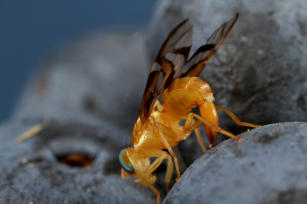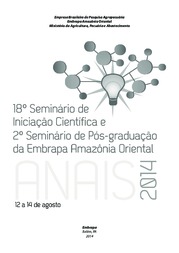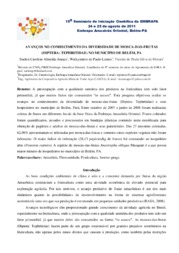Amazonian Research Network on Fruit Flies - Stage II
Amazonian Research Network on Fruit Flies - Stage II

Photo: LANZETTA, Paulo
The limited knowledge concerning the diversity of species of fruit fly species (Diptera: Tephritidae), on top of the reduced number of researchers working on this biological group in the Amazon region, has motivated the structuring of the Amazonian Network of Fruit Fly Research, a project financed by Embrapa (Call 05/2006 - "Agrofuturo"; SEG code 02.06.05.003), for the period of 36 months (August/2007 to July/2010). The Network has Embrapa Amapá as executing institution and gathers researchers from several institutions in 10 Brazilian states. Said project has expressively contributed to the advance of scientific knowledge on this group of insects in strategic areas of the Amazon, and also to the training and settlement of human resources in the region. However, knowledge is still scarce and resulting from surveys carried out in some states. Thus, in order to bridge such gaps, the" Amazonian Fruit Fly Research Network - Stage II" was proposed, aiming at the consolidation of the research group in the region, and at generating and disseminating information on Brazilian Amazon fruit fly diversity, distribution, host plants, natural enemies, and management, with emphasis on socioeconomically and quarantinedly important species. New partnerships have been established, enabling research themes to be approached more densely and deeply than in Stage I. The research activities will be based on samples of socioeconomically expressive and wild fruits, especially focusing on hosts of Bactrocera carambolae Drew & Hancock (in Amapá state), a species that is restricted to the state, and of Ceratitis capitata (Wiedemann) (in the states of Pará and Rondônia), a species that is widely distributed in the domestic territory. Surveys with McPhail-type traps will be conducted so as to obtain ecological data on Anastrepha species in the states of Acre, Amapá, and Roraima. Surveys with Jackson traps, added with C. capitata-specific pheromones, will be held in order to possibly detect the species in states where it has not been found yet. Molecular and morphometric characterization of Anastrepha striata and Anastrepha fraterculus will performed with the aim of obtaining information on the genetic diversity of A. striata in the Amazon region and of A. fraterculus in Amapá state. Larvae of different fruit fly genera will be identified based on molecular and morphometric analyses, and an illustrated key based on their morphologic characteristics will be produced. These studies will be especially useful to public agency inspectors concerned with quarantine issues. The effectiveness of botanical and synthetic chemical insecticides will be tested for the control of Anastrepha fruit flies of importance for the Amazon. Statistical tools will be used to estimate and quantify ecological parameters and their correlations with meteorological variables in the study areas. Formulations of isolated Metarhizium anisopliae and Beauveria bassiana fungi will be developed for the control of immature stages of Anastrepha in lab conditions. Finally, emphasis on the training of human resources at undergraduate and postgraduate levels will be given to ensure the continuity of studies on Amazon fruit flies. Thus, the implementation of the present proposal intends to consolidate a fruit fly research group in the region, and minimize the risk of Carambola fruit fly dispersing to other Brazilian states.
Ecosystem: Amazonic, Cerrados Region
Status: Completed Start date: Fri Apr 01 00:00:00 GMT-03:00 2011 Conclusion date: Tue Mar 31 00:00:00 GMT-03:00 2015
Head Unit: Embrapa Eastern Amazon
Project leader: Walkymario de Paulo Lemos
Contact: walkymario.lemos@embrapa.br


